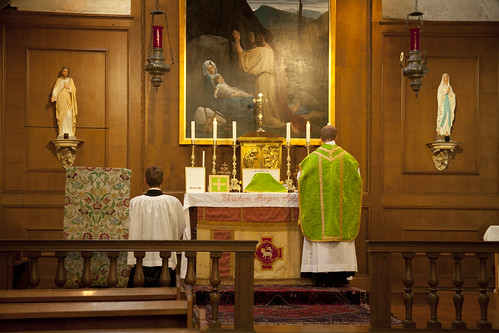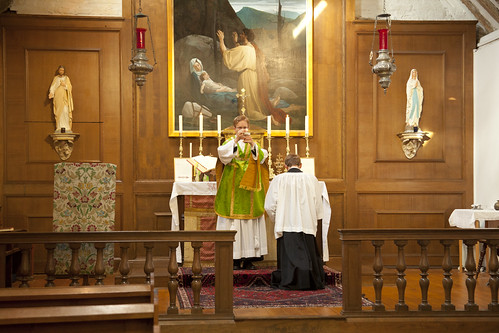 |
| Low Mass at the Evangelium Conference. |
I have now bought the English-language book of the proceedings of the Congress, and the relevant pages are now online on the Latin Mass Society website. Making this available (which is 'fair use' as far as copyright is concerned) is an important work for the Church. I have also commissioned a fresh translation of the Decree of the Sacred Congregation for Rites, Santissimam eucharistiam, which followed the Allocation and refers to it, and put a Latin-English parallel column version online as well.
Allocution: Decree. So now everyone has access to these two short but very interesting documents.
The Allocution is very interesting indeed; it is recorded in the Acta Apostolicis Sedis, so it is an official, magisterial document. Although at the beginning and the end Pope Pius XII makes a point of praising the Liturgical Movement, the contents of the Allocution is in fact a series of criticisms of worrying trends associated with it.
Against the confusion of roles of celebrating priest and congregation (clerical or lay):
When the consecration of the bread and wine is validly performed, the entire action of Christ himself is accomplished. Even if all that follows cannot be carried out there is still nothing lacking to the offering of Christ. When the consecration is completed, the “oblation of the Victim placed upon the altar” may be done and is done by the celebrating priest, by the Church, by the other priests and by each of the faithful, but this action is not the “action of Christ Himself through a priest sustaining, and acting in, His person.” In truth the action of the consecrating priest is the very action of Christ, who acts by His minister.
Against the attack on the Real Presence.
For them the essential content of the species of bread and wine as they stand is “Christ in heaven,” with whom the species have a so-called real, essential relation of containing and of presence. This speculative interpretation raises serious objections when it is put forward as completely sufficient, for the Christian sense of the faithful, the constant catechetical teaching of the Church, the expressions of the Council and particularly the words of our Lord, require that the Eucharist contain Christ Himself. The sacramental species are not Christ, even if they have a so-called essential relationship of containing and of presence with the substance of Christ in heaven. Our Lord said: “This is my body! This is my blood!” He did not say: “This is a sensible appearance which signifies the presence of my body and my blood.” Doubtless the sensible signs of a real relation of presence would be the sensible and efficacious signs of sacramental grace; but We are here concerned with the essential content of the “eucharistic species,” not with their sacramental efficacy. One cannot, then, admit that the theory of which We are speaking does full justice to the words of Christ, that the presence of Christ in the Eucharist means no more than this and that this suffices to be able to say in very truth of the Eucharist: “It is the Lord” (cf. John 21:7).
Against the view that the Tabernacle should be placed away from the Altar where Mass is celebrated.
It is not so much to the material presence of the tabernacle on the altar as to a tendency toward a lesser esteem for the presence and the action of Christ in the tabernacle that We would like to draw your attention. The sacrifice of the altar is considered sufficient, and the importance of Him who accomplished it is diminished. But the person of the Lord must occupy the centre of worship, for it is that which unifies the relations of the altar and the tabernacle and gives to them their meaning.
Not much comfort for Loftus here. But here's the killer. The next sentences are:
It is first of all by the sacrifice of the altar that our Lord makes Himself present in the Eucharist and He is in the tabernacle only as memoria sacrificii et passionis suae, a “memorial of His sacrifice and passion.” To separate the tabernacle and the altar is to separate two things which should remain united by their origin and their nature.
The question of how the tabernacle could be placed on the altar without interfering with celebration facing the people admits of several different solutions. On these the experts will give their opinion. The essential thing is to have understood that it is the same Lord who is present on the altar and in the tabernacle.
 |
| 'it is the same Lord who is present on the altar and in the tabernacle.' |
The last two excerpts hardly seem to confirm your position, Dr Shaw. The second to last passage does not seem to demand that the tabernacle be on the altar where the primary public Mass is said/sung. The last quotation contributes little at all to the thesis that Papa Pacelli opposed versus populum in the least, only that it is an on-going experiment.
ReplyDeleteWhat do you take 'my position' to be?
DeleteThey couldn't demand that the tabernacle always be on the primary altar of a church because it wasn't in the great basilicas.
In your previous post on this subject you attack Msgr (Fr?) Loftus for suggesting Pope Pius XII favored much of the Liturgical Movement's nonsense. In your retort there, and here above, you list quotations which condemn the idea that the tabernacle should be placed on an altar where Mass is not celebrated or that Mass facing the people trumps the tabernacle's importance. One might get the wrong impression that Pius XII either opposed Mass facing the people or that he demanded the tabernacle be on the main altar of a given church. Legally speaking the latter was never the case, although it was common; the old law was only that the tabernacle be on the most adorned altar. Concerning the former Pius XII never did anything to stop Mass versus populum and even gave its enthusiasts some fodder by endorsing elements of the Liturgical Movement, which had for decades strayed form its original track.
DeleteIn short the arrangement of your quotations would seem to indicate you think Pius XII generally wished the tabernacle to be on the primary altar of a church and for it not to be moved for the sake of versus populum. The passages do not make that case. If that is not your position then what are you trying to say?
I don't say what you say is not true. If you want to know what I do say, read what I've written! Particularly the next post.
DeleteOne church in Hexham & Newcastle not only moved the tabernacle to a side altar, but stacked chairs in front, of the said side-altar, precluding the opportunity for prayer before the Blessed Sacrament. The rest of the high altar was reduced to something masonic.
ReplyDeleteThe Arc of the covenant had Gods Presence & was in the centre, most Holy position in the sanctuary of the Jewish temple. Now the centre most Holy position in a church is the Altar & therefore the Tabernacle containing Gods physical presence should also be located in the middle of the holy Altar. It's a no brainer.
ReplyDelete